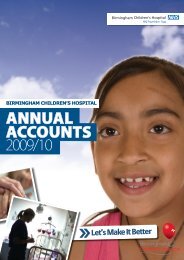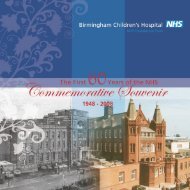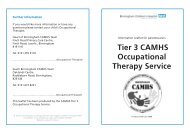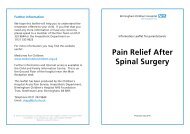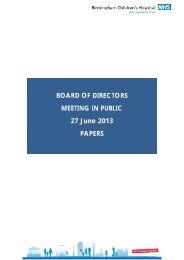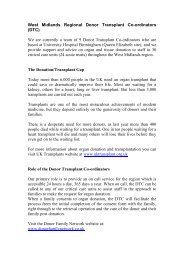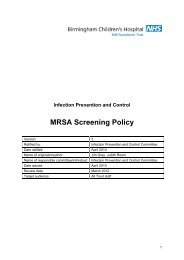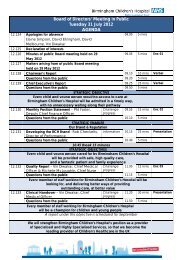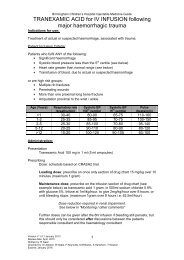Nurses Day! - Birmingham Children's Hospital
Nurses Day! - Birmingham Children's Hospital
Nurses Day! - Birmingham Children's Hospital
Create successful ePaper yourself
Turn your PDF publications into a flip-book with our unique Google optimized e-Paper software.
BACK TO CONTENTS PAGE<br />
Figure 31: SMR Funnel Plot February 2013<br />
250<br />
200<br />
150<br />
Marker by<br />
TRUST NAME<br />
Color by<br />
Alert Level<br />
Amber<br />
Green<br />
Shape by<br />
Peer Flag<br />
Pre-selected Peer(s)<br />
Your Organisation<br />
What are people talking about? This Word Cloud<br />
demonstrates by their size the most frequently used<br />
words in all the patient feedback we received in<br />
2012/13. The larger the word, the more frequently it<br />
has been used.<br />
RRM<br />
100<br />
50<br />
0 20 40 60 80 100 120 140 160 180<br />
Number of Expected Deaths<br />
Patient Feedback<br />
Listening to what our children, young people and<br />
their families tell us about their experiences at BCH<br />
and their views about our services is vital in making<br />
sure we continue good practice, and make changes<br />
where improvements are needed.<br />
It is really important that we gather this feedback in<br />
lots of different ways so we can make sure we are<br />
taking account of everyone’s views. We call this<br />
our Patient Experience Toolbox, and we load all the<br />
information we obtain into our Patient Experience<br />
Database which helps us identify themes or areas<br />
that need closer attention. It also helps us make<br />
sure that we can let our staff know when we receive<br />
really good feedback.<br />
The toolbox includes patient surveys, quality<br />
walkabouts, patient stories, mystery shoppers,<br />
focus groups, feedback cards and direct feedback<br />
like letters and comments. Combining this<br />
with information about patient experience from<br />
other sources – such as PALS contacts and<br />
formal complaints - provides an overall picture<br />
of individual wards and departments and of the<br />
whole Trust. It also helps us see what we do well<br />
and identify areas for improvement. As a result of<br />
this work we have set new quality objectives and<br />
made service improvements in areas like food,<br />
play, communication, environment and patient<br />
information.<br />
As well as looking at what we need to improve,<br />
it is also important to look at what patients and<br />
their families tell us we do well. This provides vital<br />
learning about how we can improve other areas,<br />
and it is important to take this into account when<br />
we are thinking about changing something. Sharing<br />
positive feedback with staff about the work that they<br />
do also supports and motivates them to deliver the<br />
highest quality of care that they can.<br />
132 133




